West Island Chiropractor
- January 2024: We've moved! See our new address.
-
January 2024: We've moved!
See our new address.
Our mission and purpose is about wellness, but more importantly wholeness.
It is all about you!
We aim to provide state of the art, gentle chiropractic care within a calm, inviting environment.
We want your experience to be one of a kind. That’s our promise!
I have been a practicing chiropractor since 2000 having served thousands of practice members.
My focus is on educating, promoting and living a true principled chiropractic lifestyle (this is the unique understanding that the body is a self-healing, self-regulating entity that aims at adapting its functions to an ever-changing environment)
I have served as the Montreal Alouettes team chiropractor from 2003 to 2012.
Currently, I serve as the Chief Examiner (Québec) for the Canadian Chiropractic Examining Board. The CCEB conducts clinical competency examinations for individuals seeking licensure to practice chiropractic in Canada.
We walk the walk, staying true to our chiropractic roots. Our unique approach, caring, and understanding of natural healing and regulation ensures an incredible and unmatched experience.
Chiropractic is not only an art, a philosophy, and a science: it is a lifestyle!
Give it a try, and I guarantee you will not be disappointed!
Sincerely,

Nayla is the welcoming face of Centre Chiropratique Pointe-Claire!
Nayla is an integral part of the clinic’s daily operations. Her warm and friendly smile puts patients at ease from the moment they enter the clinic. She takes care to guide you throughout your treatment plan.
Nayla’s organizational skills ensure that the clinic runs smoothly! She manages appointments with precision, ensuring that each patient is seen promptly while allowing enough time for them to receive personalized care.
Chiropractic aims at recovering, restoring and maintaining a good nervous system balance. The idea is to identify areas of restricted movement within the spine and then restore proper alignment. This is important for healing and function.
Without proper function, healing is impaired.
When a spinal bone is out of alignment, the nervous system is unable to function properly.
Chiropractic helps restore your body’s natural ability to heal itself.
- Back pain
- Neck pain
- Pinched nerve
- Sports injuries
- Headaches / migraines
- Posture
- Tingling / numbness
- Scoliosis
- Osteoarthritis
- Work related injuries
- Disc degeneration / herniation
- Low energy / fatigue
- Stress response
- Inflammation
- Recovery
- Pregnancy related discomfort
What can I expect on the first visit?
On your first visit, expect a comprehensive evaluation of your spinal health and nervous system:
- Visual and manual inspection of postural alignment
- Static and dynamic palpation of your vertebrae, looking for swelling, abnormal movement, reduced mobility
- Neuro-musculo skeletal assessment
- Orthopedic testing
- Functional evaluation of the autonomic portion of your nervous system
- X-ray or imaging referral (if needed)
- Report of findings
Following this comprehensive examination, we can determine whether or not chiropractic care can help you.
Our approach is efficient, our techniques are gentle, our results are amazing.


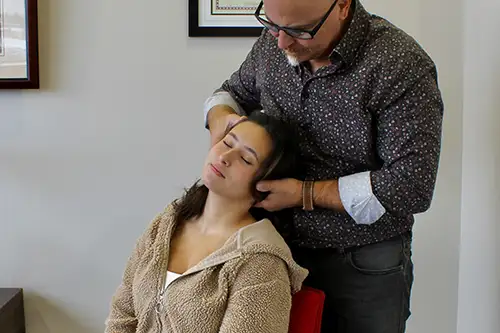
This technique is widely recognized as one of the best approach in spinal adjustments.
A manual full spine, pelvis, and extremities adjusting technique, the focus of the Gonstead adjustment is to be as specific, precise, and accurate to ensure a biomechanically correct position to make the adjustment as gentle and safe as possible.
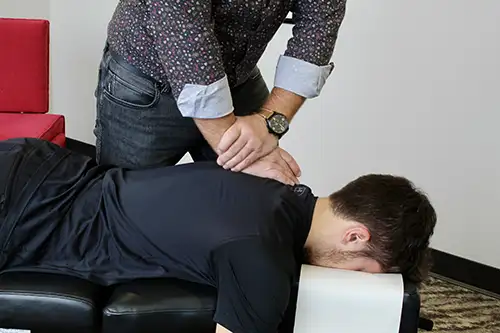
This is a low-force technique involving the use of a specialized table with moveable drop pieces.
The inertia of the dropping part of the table allows for a comfortable, specific adjustment with minimal pressure on the spine or body part.
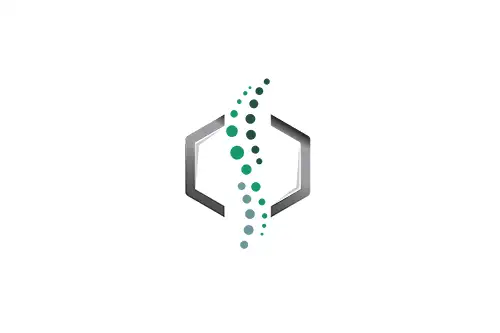
The PulStar adjusting instrument puts a light vibratory force into each vertebra and will sense the feedback from the bone as to how resistive it is to that force. It also measures the quality of motion of the bone(too much or too little). This information is then displayed graphically to easily locate which joints are not “playing along” in spinal function.
The computer will calibrate the instrument accordingly to which joints should be adjusted. The instrument uses repetitive adjusting impacts to restore joint function. It’s also sensing the motion and varying the frequency of impact to ensure maximal effectiveness and comfort.
The session is in 3 phases: pre-analysis- adjustment/correction- post-analysis. It provides us with real-time, objective feedback. This technology is accurate, objective, gentle, and effective.
What's a chiropractor?
A chiropractor, also known as a “chiro”, is a health professional that aims to improve your health.
How? By optimizing patients’ vitality and joint mobility.
Did you know? In many countries, chiropractors are considered the first line of health practitioner.
Does my insurance cover chiropractic care?
Most private insurance plans reimburse a portion of fees for chiropractic care.
As insurance coverage varies, it’s best to ask your insurance provider directly.
Note that in Quebec, the Régie de l’assurance maladie du Québec (RAMQ) does not cover chiropractic care.
Why see a Chiropractor?
Many people seek chiropractic care when they have chronic pain, fatigue, lack of energy, digestive problems, muscle aches, numbness, and tingling. All of these issues can be addressed with chiropractic care.
A chiropractor treats all joints and the tensions linked to stress.
A patient can very well suffer from a painful back, which is not necessarily linked to a joint issue, but often to muscle tensions.
What is the cost of treatment at Centre Chiropratique Pointe-Claire?
Fees typically cover new patient fee, chiropratic & neurological examinations.
New Patient Initial Examination: $100
Chiropractic Adjustment Visit: $60
Progress Examination: $50
What can I expect on the first visit?
Please refer to the above section for the answer.
Do I need a doctor's referral?
No, not necessary.
Many people believe a medical referral is needed to see a chiropractor, but for most cases, it’s not necessary!
What is the academic path to becoming a chiroprator, in Quebec?
In Quebec, chiropractors must follow a 5 year university program, offered by the Université du Québec à Trois-Rivières (UQTR), which earns you a doctorate of chiropractic.
Then, you have to apply for and pass the Canadian (Chiropractic Canadian Board) & Quebec exams.
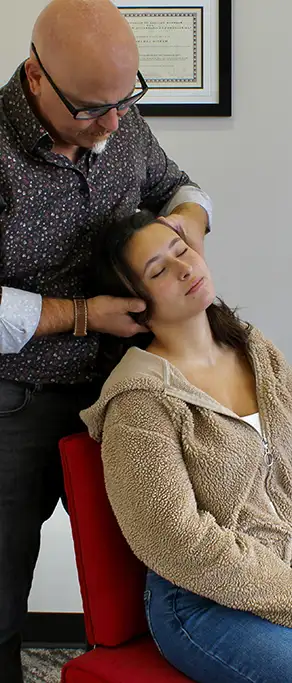
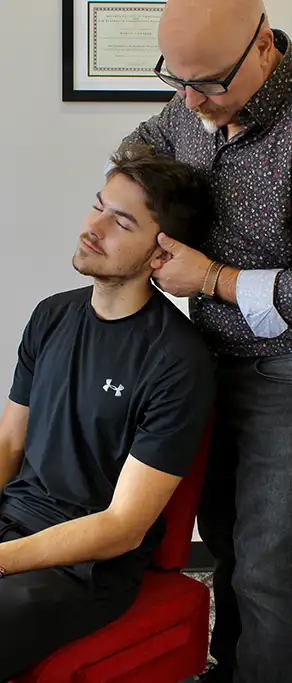
Chiropractic is a distinct healing art that focuses on the body’s natural inborn ability to self-heal and self-regulate. Every day, our body strives toward maintaining the proper functioning and coordination of all its operational systems. Your nervous system carefully monitors this task.
The primary goal is not only focused on merely alleviating the pain often experienced in and around the back.
Instead, the objective is to ensure that the nervous system, your communication superhighway, is apt and able to relay efficiently information back and forth between your body and brain.
This process is of vital importance because the nervous system, housed within the spine, controls and regulates the entire body.
This phenomenon is the body’s natural, inborn ability to heal and self-regulate.
Every day the body strives to maintain proper functioning and coordination of all its operational systems.
A delicate balance
Your brain acts as a conductor, controlling and coordinating all body functions within your skull. Your brain and spinal cord make up the Central Nervous System, whereas the network of nerves connecting them to the body make up the Peripheral Nervous System.
The spine is made up of 24 bones which cover and protect the spinal cord. The spinal cord has 31 pairs of spinal nerves which exit from between the spinal bones.
Although the spinal column offers protection to these sensitive spinal nerves, this delicate balance can be disrupted.
When the spinal bones are not moving as they should, if they are stuck, fixated, or even misaligned, this may cause interference within the nervous system and inhibit the vital communication between the brain and the rest of the body, further compromising the proper functioning of all body systems.
This issue is called a SPINAL SUBLUXATION.
A subluxation may be caused by any physical, chemical or emotional stresses, which exceeds your body’s adaptive ability.
By correcting and minimizing the effects of subluxation, our objective is to:
- Improve the function of the spine and enable people to be optimally active and energetic
- Restore, maintain and optimize the nervous system so that the signals that circulate within have full access to tissues and body systems
- Keep the communication channels open between the body, mind and spirit
The next time you may be confronted with what seems to be an irritating symptom, you should wisely consider it to be your body’s appropriate response to an environmental or lifestyle stress. It may be a signal telling you what not to do to help the body restore itself and further optimize health.
Most often, symptoms are a result of the body functioning as it was intended to.
The Chiropractic philosophy recognizes that within each person one finds a self-healing, self-regulating intelligence that, without interference, is all you need to achieve a state of optimal health and well-being.
Having symptoms, in most cases, is an essential part of healing and being healthy. Masking symptoms with medication, or other types of therapy, may not be ideal and can be counterproductive to your body’s attempts to adapt itself to new challenges.
That being said, the first objective of chiropractic care will be to alleviate any pain or discomfort.
However, the principal focus of your care plan will be far more than this.
Out of respect for your Innate Intelligence, the ultimate goal will focus on removing the interference between the brain and the body to restore optimal health.
These messages (symptoms) are relayed across the body’s communication network -the nervous system.
When transmission of these messages is free of any interference, the brain and immune system are more likely to generate a healthy response.
Chiropractic care has been shown to improve balance, agility and coordination in athletes, making it a critical component of your athletic training plan.
Chiropractic care is helpful for strengthening the musculoskeletal system, which makes it easier to maintain normal balance.
Remember, chiropractic care helps your nervous system function normally. The nervous system is responsible for movement, so chiropractic treatments may make it easier to coordinate the movements of your body whenever you need to accomplish a sports-related task. If the spine isn’t moving optimally, the body has to start compensating for that lack of movement. When it begins to compensate, it decreases efficiency, wastes energy, and is unable to perform at as high a level.
Ideal movement in the spine will trigger sensors that informs the brain about the body’s position in space: it’s called proprioception.
If those sensors aren’t moving, the brain doesn’t get enough information about its position in space. If your brain doesn’t have enough information to know where it is in space, whether you’re working out or doing sports, it’s more likely to get injured. Stiffness reduces your flexibility, increasing the risk of injury and affecting your performance.
On the other hand, if your brain has all the information about what’s going on in the environment, you can make better decisions, which helps prevent injuries and improve performance.
When your spine is more efficient, your brain is more in tune with your body. You’re more at ease and relaxed. Your body can be in a state of stress, Sympathetic (fight or flight), or Parasympathetic (rest and repair). If our spine is out of alignment and we have extra tension–lack of movement in the spine–our body will default to going more into the stress tension response (Sympathetic state).
If we can get into a more Parasympathetic state (rest and repair), that allows the body to heal faster. The whole nervous system goes more into a rest state, and you’re improving the mechanics of the spine and posture simultaneously. When that happens, you can participate in your favorite sports or activities and perform at your best.
Posture refers to the way we carry the body while sitting, standing, or lying down. A good posture is referred to as neutral spine.
The benefits of good posture are obvious: not only you look better, you have increased energy, better breathing, improved circulation, less wear and tear, and better overall health.
Conversely, the effects of bad posture can be dramatic. When we have poor posture, we automatically have poor mechanics, which is called flexor dominance. That typically means your body is bent forward in a protective position. Usually if you’ve been injured, tired, or have been under chronic stress, your body goes into that protective posture. If you’ve been in that posture for a while, your spine will have a difficult time extending. Your spine will work too hard to maintain its neutral position, leading to a chronic protective stress response. Both your mental and physical health will suffer from this.
To have good posture, you need strong extensor muscles.
The only way to have strong extensor muscles is to extend your spine comfortably. If you can’t comfortably extend your spine, and the muscles get weak, you’ll experience even more forward head posture.
Chiropractic care will allow the extensor muscles of your spine to regain their strength and flexibility, allowing better movement leading your brain to be more in tune with your body therefore improving posture.
Our modern lifestyle is filled with potentially stressful daily challenges or threats: excessive work hours, family conflicts, raising children, important events, deaths.
Moreover, these stresses increase when we subject ourselves to low levels of physical activity, long working hours and poor dietary habits.
Stress will occur when a situation is more demanding than what your body can cope with.
Usually, the way our bodies respond to stress or a perceived threat is pretty normal. It’s known as the fight or flight response…a healthy response that will get us through a difficult situation.
For example, when you encounter a perceived threat (such as a car coming fast at you), your hypothalamus, a small region at the base of the brain, sets off an alarm system in your body. Through a combination of nerve and hormonal signals, this system prompts your adrenal glands to release a surge of hormones, including adrenaline and cortisol. Adrenaline increases your heart rate, elevates your blood pressure and boosts your energy supplies. Cortisol, the primary stress hormone, increases sugars (glucose) in the bloodstream, enhances your brain’s use of glucose and increases the availability of substances that repair tissues.
Cortisol also curbs functions that would be nonessential or detrimental in a fight-or-flight situation. It alters immune system responses and suppresses the digestive system, the reproductive system and growth processes. This complex natural alarm system also communicates with the brain regions that control mood motivation and fear.
The body’s stress-response system is usually self-limiting. Once a perceived threat has passed, hormone levels will return to normal, adrenaline and cortisol levels drop off again, your heart rate and blood pressure return to baseline levels, and other systems resume their regular activities.
However, when this stress response is persistent and ongoing, it will take a toll on the body. The body’s surveillance system is in overdrive, forcing the nervous system in an unsustainable functioning mode. Pain, anxiety, irritability, depression can result from this.
Common signs and symptoms:
- Fatigue
- Muscle tension and stiffness
- Aches or pains
- Brain fog and loss of concentration
- Inability to sleep
- Headaches or migraines
- Suppressed immune system
The consequence of increased levels of stress and traumas in today’s world requires the human body to be at its adaptive best. How well you are is determined by your ability to adapt to life’s physical, chemical and emotional stresses.
And for your body to be at its adaptive best, your brain and nervous system need to feel safe and calm as we are wired for protection and connection
This is where chiropractic care comes in: as we adjust the spine, we are stimulating the adaptive centers of the brain which provides a safe, predictable environment for the nervous system so it can reorganize and regulate properly.
One of the most common by-product caused by sustained physical, chemical and emotional stresses are subtle misalignments of the spine called subluxations.
Unfortunately, subluxations which are caused by too much stress, reduce the body’s coping abilities. Increased levels of stress then leave you more susceptible to subluxation and a vicious cycle results.
Those who feel healthy and well are those who can best adapt.
If your nervous system is free of interference, it is better equipped to deal with daily stress.
Helping you become more adaptive to deal with the stresses life may throw your way is our ultimate goal.
